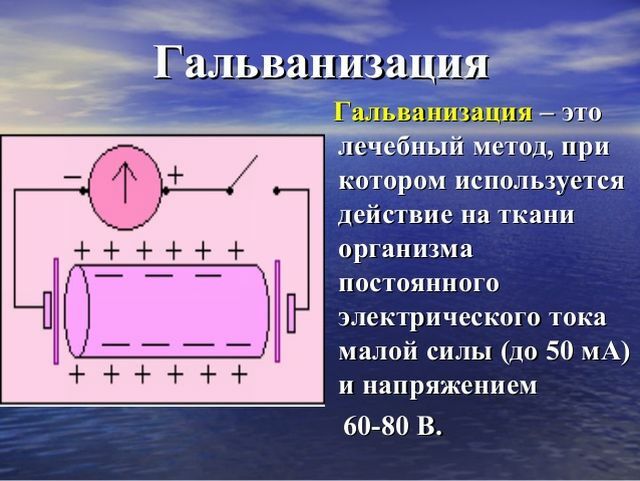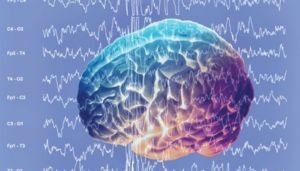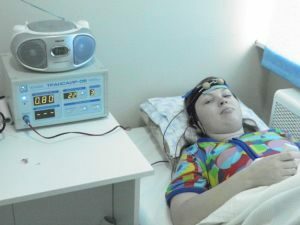 Transcranial electrostimulation( TPP-therapy) is a transcranial method of therapeutic treatment of the brain by means of impulse currents.
Transcranial electrostimulation( TPP-therapy) is a transcranial method of therapeutic treatment of the brain by means of impulse currents.
Weak currents are fed through electrodes attached to the patient's head. Electric currents affect the protective functions of the brain, change the bioelectric activity in the GM.
TPP-therapy was developed on the basis and principles of evidence-based medicine, which is one of the few physiotherapy methods recognized in medical circles.
Therapeutic effect of
The mechanism of the therapeutic effect of transcranial electrostimulation is the effect on the mechanisms of endorphins production in the brain. During the procedure, stimulation of sensitive and analgesic structures of the brain occurs through the penetration of current through the bone and soft tissues of the head.
The influence of current promotes activation of endorphins production, their concentration rises in blood, cerebrospinal fluid and in the brain. The hormone endorphin is involved in the normalization of various disorders in the human body, without affecting the processes proceeding normally.
Due to the active development of endorphin, the analgesic effect of the procedure occurs, since its effect relieves the pain syndrome much more actively than morphine.
Stabilization of the patient's psychoneurological status occurs due to antidepressant effect, antistress effect, normalization of sleep, mood improvement and increase of patient's efficiency.
TPP-therapy promotes acceleration of healing processes of various tissues of the body( skin, mucous membranes), regeneration of peripheral nerves, regeneration of liver parenchyma cells. Has a stimulating effect on immunity.
Favors growth retardation of benign and malignant neoplasms. TES-therapy also has a beneficial effect on the normalization of the body's physiological status.
The effect of the procedure lasts for several days, and gradually the body's defense system is trained.  TPP-therapy promotes the "learning" of the body to actively produce endorphins naturally. This physiotherapy method is not addictive.
TPP-therapy promotes the "learning" of the body to actively produce endorphins naturally. This physiotherapy method is not addictive.
It is possible to combine transcranial electrostimulation with other treatments( other physiotherapy, medication, manual therapy, balneotherapy), except for reflexotherapy and the use of morphine-like analgesics.
Systematic use of TPP-therapy allows you to partially or completely abandon the use of pharmaceuticals( hormonal drugs, antidepressants, immunomodulators, analgesics).
Studies have shown a high effectiveness of transcranial electrostimulation in the treatment of neurological diseases - a decrease or complete disappearance of symptoms occurred in 80-90% of cases.
Basic parameters and methods of
procedure Before the beginning of the therapeutic course, it is necessary to get consultation from a neurologist and physiotherapist.
It is not recommended to take a therapy session after a meal, it is necessary to observe a 2-hour time interval between food and a session.
During the procedure the patient occupies a sitting or lying position. Electrodes are placed on the forehead, occiput and mastoid processes of the patient.
In the area where the electrodes are applied, the skin should be cleaned, free of damage and rashes. On the ears should be no jewelry. During the session, tingling sensations, a feeling of slight vibration, in the area of exposure are possible. Also, the patient may experience a flicker of light, while the eyes are closed. Electrodes do not leave traces or damages on the skin.
During the procedure pulse currents of small amplitude( 3 mA) are used, having a rectangular bipolar pulse shape.
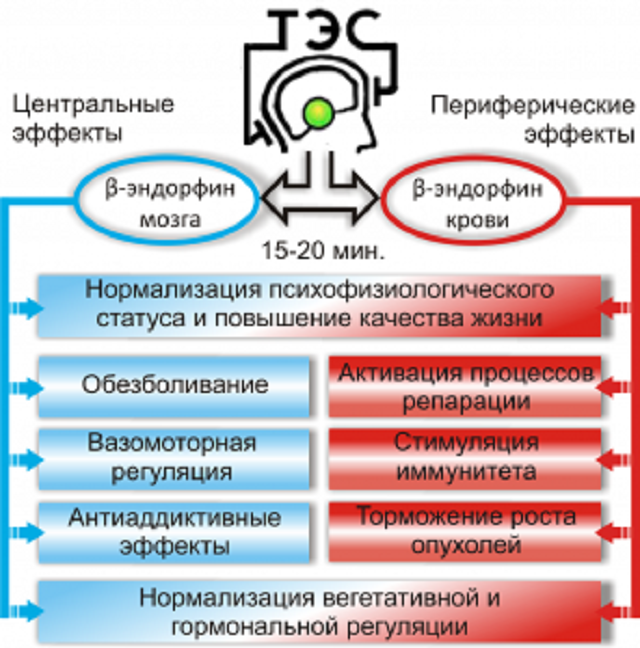
During the first session, it is recommended to apply the minimum current value( up to 0.5 mA).At the first session of TPP therapy, the current value is not increased, even in the absence of sensations in the patient, however, in the following procedures, the increase in current occurs before the appearance of these sensations. In case of discomfort during the session, it is necessary to reduce the current. The average current level recommended for the procedure is 1.5 mA.The procedure is completed by reducing the current to zero.
Sensations of current must be maintained throughout the procedure, but should not cause significant discomfort. The current must be adjusted according to the sensations. When the positive effect is achieved, subsequent procedures should be carried out at the same current indices without increasing them.
In the case of severe pain, several sessions per day are possible with an interval of 4-6 hours. With the preservation of pain syndrome, a doctor's consultation and repeated, additional examination are needed to clarify the diagnosis.
The effect on the alpha rhythms of the brain and, accordingly, the stimulation of the production of endogenous opioid peptides occurs at frequencies in the range of 70 to 80 Hz.
 Patients with blood pressure disorders require a short rest at the end of the procedure( 15 minutes).It is also recommended to carry out massage of the neck-collar zone.
Patients with blood pressure disorders require a short rest at the end of the procedure( 15 minutes).It is also recommended to carry out massage of the neck-collar zone.
One session of TPP-therapy lasts up to 20 minutes, however, with an acute pain syndrome, an increase in duration is possible. The standard therapeutic course consists of 15 procedures.
For acute and acute chronic diseases, the course is aimed at relief of the main symptoms, and does not exceed 5 procedures. Passing a second course is possible in 2-3 months. Within a year, no more than 60 procedures are carried out.
Indications and contraindications for the use of the procedure
Transcranial electrostimulation shows its effectiveness in such neurological pathologies:
- depression;
- stress;
- sleep disorders;
- hyperactivity, attention disorders;
- increased fatigue;
- chronic fatigue syndrome;
- increased anxiety;
- menopause neurosis;
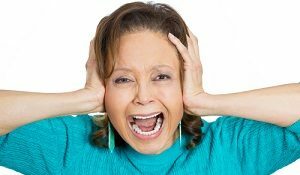
- disorders of autonomic regulation;
- orofacial pain;
- sciatica nerve disease;
- pain syndromes in osteochondrosis, radiculitis, neuralgia;
- inflammation of the trigeminal nerve;
- headaches of various origins;
- meteotropic reactions;
- discircular encephalopathy;
- movement disorders after a stroke;
- phantom pain;
- pain in cancer;
- Parkinson's disease.
Also, the use of TPP therapy is recommended for such diseases and conditions:
- vascular disruption;
- blood pressure abnormalities in hypotension, hypertension;
- Sensorineural hearing loss;
- decreased visual acuity, pain in the eyes;
- burns, ulcers, trophic ulcers, trauma to the skin and connective tissues, postoperative wounds;
- low immunity;
- neoplasm;
- toxemia during the first trimester of pregnancy;
- neurodermatitis and dermatosis, seborrhea, eczema;
- endometriosis;
- alcoholism, drug addiction, alcohol withdrawal syndrome;
- allergy and allergic conditions( bronchial asthma, rhinitis, diathesis, pollinosis);
- hormonal imbalance;
- inflammatory processes;
- peptic ulcer, gastritis, duodenitis;
- osteoarthritis;
- ischemic heart disease.
Transcranial electrostimulation is not recommended for the following conditions:
- convulsive syndrome, epilepsy;

- thalamic pain;
- head trauma and neoplasm in the brain;
- essential hypertension of the 3rd degree;
- hypertensive crisis;
- infectious lesions of the central nervous system;
- hyperthyroidism;
- mental illness during an exacerbation;
- angina attack;
- hydrocephalus;
- Brain Injuries( Closed);
- atrial fibrillation;
- skin lesions at the site of exposure;
- diencephalic syndrome;
- implanted pacemaker;
- small age( children under 5 years).
Apparatus for TPP-therapy
Methods of thermal therapy are used in more than 300 clinics in Russia, CIS countries, Bulgaria, Israel, the USA and Canada. The most widespread are such devices:
- Transair - a series of devices for home, polyclinic, clinical and stationary applications. Transair-02 is a device for home treatment, Transair -01V is a small-sized two-program device for use by doctors, Transair-01C is a three-program stationary device, Transair-01P is a clinical multiprogram device.
- Magnon is a stationary device for clinical and polyclinic use.
- Doctor TES-03 - does not require power from the network, is intended for home use.
- ETRANS-1 and ETRANS-2 - portable devices, ETRANS-3 - multichannel device for simultaneous treatment of 4 patients.
- MDM-1 - apparatus for simultaneous therapy of 10 patients, MDM-101 - apparatus for simultaneous therapy of 4 patients.
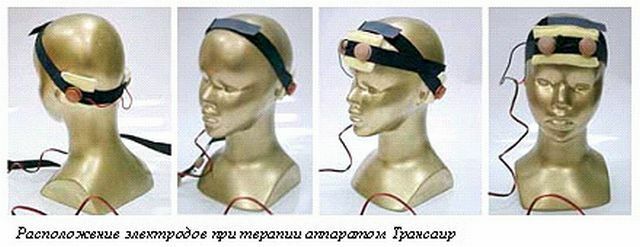
It should be remembered that the achievement of therapeutic effect is possible with the correct procedure. Electrodes provide penetration of electric current into the brain through the bones and tissues of the skull. Apparatuses suggesting the placement of electrodes on ear lobes do not have efficacy.

